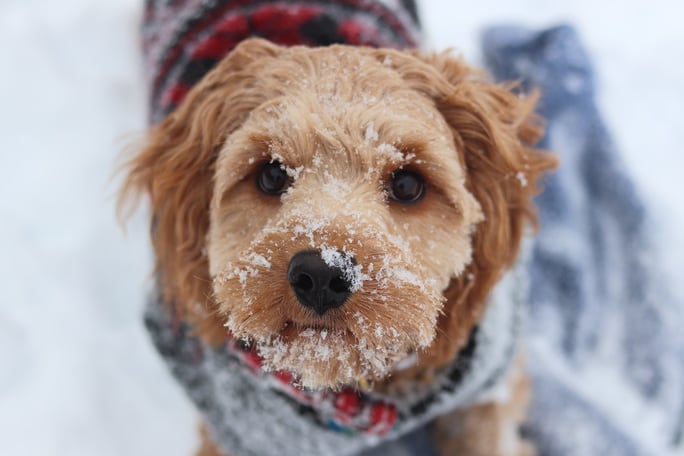How to Keep Your Pet Healthy in Cold Weather
Updated on: November 9, 2022 | Author: Starwood Pet Travel

If you think it’s tougher to stay warm and healthy in winter, think about how your pets must feel. Now is the time to consider the best ways to care for pets in cold weather, so you – and they – will be properly prepared. Remember that “cold” depends not only on the weather outside but what kind of pet you have.
Some dogs are naturally more temperature-sensitive, and that makes them more vulnerable. Your greyhound will need a toasty sweater or coat in temperatures that would have a husky mopping her brow.
Cold weather dangers for pets
Pets can suffer from both physical and health-related problems in winter:
- Every dog and cat goes barefoot when they venture outside.
- Repeated exposure to wet or frozen surfaces can cause paw pads to become chapped or split, and they may bleed. Extreme cold can cause chapped noses, too.
- Chemicals found in deicer and antifreeze are poisonous. They can be deadly if your pet gets any on its feet and then ingests it by licking.
- Repeated trips from your warm, dry house to the cold outdoors and back can cause dry skin. You may notice your pet scratching.
- Any pet – especially those more susceptible to cold – can develop hypothermia and get frostbite.
What should you do?
- Wipe up any antifreeze spills. (Better yet, purchase the product made from propylene glycol instead of ethylene glycol, because the former is less toxic.) Try to keep pets away from areas where deicer has been used.
- Always wash or thoroughly wipe down pets that have been outside. Get the paws, but also wipe down the legs and belly fur. This is especially important for cats and shorter dogs whose underside is more likely to come in contact with water or snow. Be sure to check for and remove ice balls in the fur between their pads. (You can trim that fur if it is very long.)
- If you live where it is very cold, invest in booties for your dog, especially if you plan to play outside, not just make relief runs. Make sure they fit properly.
- Buy a raincoat with a hood, padded coat, and/or sweater with a turtleneck for your dog. Get more than one sweater or coat, so they’ll always have a dry one to wear.
- Keep vulnerable pets indoors as much as possible.
- If you have a cold-weather dog breed, make sure they have a dry doghouse. It should be big enough to allow standing and turning, but cozy enough to retain body heat, and elevated a bit off the ground. Face the doorway away from the prevailing wind, and cover it with a dog-door-style flap. And, of course, add a comfy bed.
- Use only plastic bowls to provide outdoor water where it freezes. Otherwise, your pet’s tongue could freeze to the metal edge.
- Never leave pets alone in your car when it’s cold. Once you shut off the engine, the interior temperature drops quickly, putting animals in danger of freezing. This is just as big a risk as leaving pets in the car in summer when it’s hot, but many people don’t realize that.
Although you may read that pets should eat more in winter for added body fat, the American Veterinary Medical Association says no. Maintaining a healthy weight is best because even a few extra pounds can cause serious health problems for dogs and cats. Along that same line, if your pet is elderly or has a chronic health challenge, ask your vet about any special wintertime actions you should take.
And if you live where winter power outages are a possibility, make sure you always have several days’ worth of pet supplies on hand, especially prescription medications.
In short, many concerns and potential dangers of pet care in cold weather are exactly the same as those that apply to humans. When you look at it this way, it will be easy to make safe, healthy decisions for your pet this winter.
Will your pet be traveling this winter?
Pet-friendly airlines take special precautions to care for pets in cold weather. Although dogs and cats ride in a temperature-controlled, pressurized cargo area, they have to be transported from the terminal to the plane and back. That sometimes involves a wait on the tarmac, and if the weather is very cold, that can quickly become dangerous.
For this reason, airlines will not accept pets for shipment if the temperature is predicted to drop below 40o F at any point along their itinerary. Learn additional information to determine which pet-friendly airline will be most suitable for you and your pet here.
Subscribe to the Blog
Enjoy our content? Get them sent to your inbox!
Subscribe Now!

